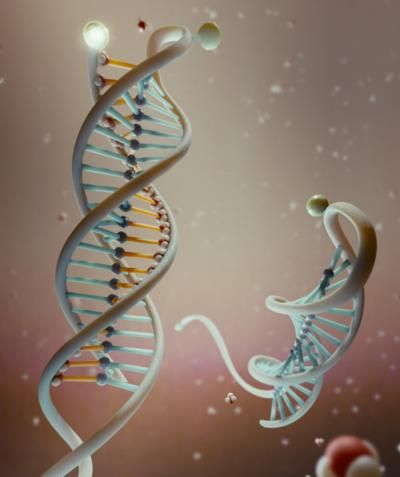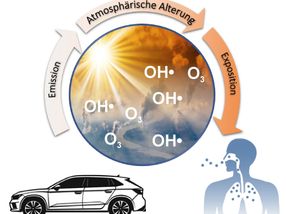Literally shine light on cancer
Patented nanosensor detects and reacts to second pH changes in cells
Bioengineers at the University of Rome Tor Vergata and the University of Montreal have used DNA to develop a tool that detects and reacts to chemical changes caused by cancer cells and that may one day be used to deliver drugs to tumor cells.

Andrea Idili, Alexis Vallée-Bélisle and Francesco Ricci have developed a DNA-based nanosensor that allows to measure pH variation at the nanoscale. This nanosensor may significantly aid efforts to build nanodevices for cancer in-vivo imaging and targeted drug-delivery. This nanosensor measures less than 10 nm and unfolds at a specifically programmed pH.
Marco Tripodi
The researchers' nanosensor measures pH variations at the nanoscale – how acidic (a higher pH level) or alkaline (a lower pH level) it is. Many biomolecules, such as enzymes and proteins, are strongly regulated by small pH changes. These changes affect in turn biological activities such as enzyme catalysis, protein assembly, membrane function and cell death. There is also a strong relation between cancer and pH.
Cancer cells often display a lower pH compared to normal cells: the pH level inside cancer cells is higher than it is outside. "In living organisms, these small pH changes typically occur in tiny areas measuring only few hundred nanometers," says senior author Prof. Francesco Ricci. "Developing sensors or nanomachines that can measure pH changes at this scale should prove of utility for several applications in the fields of in-vivo imaging, clinical diagnostics and drug-delivery."
"DNA represents an ideal material to build sensors or nanomachines at the nanometer scale" says senior author Prof. Vallée-Bélisle. "By taking advantage of a specific DNA sequences that form pH-sensitive triple helix, we have designed a versatile nanosensor that can be programmed to fluoresce only at specific pH values." Fluorescence is the emission of radiation, including visible light, caused by an exchange of energy. "This programming ability represents a key feature for clinical applications – we can design a specific sensor to send a fluorescent signal only when the pH reaches a specific value which is, for example, characteristic of a specific disease," adds first author Andrea Idili.
In the future, this recently patented nanotechnology may also find applications in the development of novel drug-delivery platforms that release chemio-therapeutic drugs only in the viscinity of tumor cells.
Topics
Organizations
Other news from the department science
These products might interest you

Hose pressure transducer by HiTec Zang
Contactless pressure measurement for sterile applications
Easy-to-install tubing pressure sensors for diameters from 4.8-19.1 mm

FireSting-PRO by PyroScience
New fiber optic measuring device: Precise measurements even in the smallest volumes
Measure pH, oxygen and temperature even under sterile conditions

Get the life science industry in your inbox
By submitting this form you agree that LUMITOS AG will send you the newsletter(s) selected above by email. Your data will not be passed on to third parties. Your data will be stored and processed in accordance with our data protection regulations. LUMITOS may contact you by email for the purpose of advertising or market and opinion surveys. You can revoke your consent at any time without giving reasons to LUMITOS AG, Ernst-Augustin-Str. 2, 12489 Berlin, Germany or by e-mail at revoke@lumitos.com with effect for the future. In addition, each email contains a link to unsubscribe from the corresponding newsletter.























































